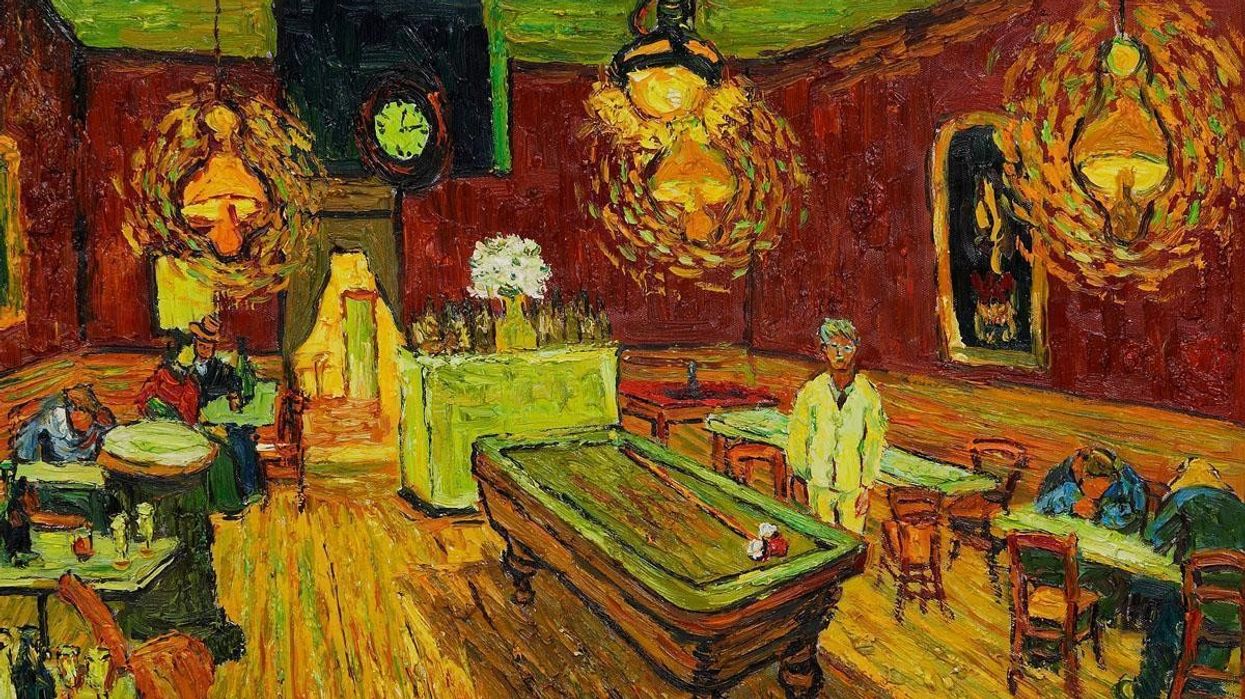What Does Van Gogh's Ugliest Painting Have to do with Filmmaking?
Three months after Van Gogh painted 'Night Cafe,' he had a mental breakdown and cut off his ear.

The only Van Gogh painting I've seen in real life is "Irises." I saw it at the Getty in Los Angeles and even took my mom's picture next to it. I mean, come on, it was a VAN GOGH. I'm not liquid enough to travel Europe examining masterpieces. But if I had that cash, maybe after the next spec sale, I'd get on a plane and fly right to see "Night Cafe," which would be a mistake because it's housed in New Haven, Connecticut, in the Yale University Art Gallery.
Today, we're going to look at a video essay about "Night Cafe" by Nerdwriter and talk about what we can learn from this self-professed 'ugly' painting from Van Gogh. So hold onto your ears and let's go!

The world's greatest artist...
In a series of letters Van Gogh wrote to his brother, he describes "Night Cafe" as the "ugliest painting" he's ever done. Van Gogh hates the colors, the people, the textures, and the lighting. They drive him mad. A few months after he completes these works, he cuts his ear off. Which is...not great.
For those of you who haven't seen the painting or want to know more about its history and reception, check out the Nerdwriter video below!
What about us filmmakers?
So what can a filmmaker learn from Van Gogh's work? Our post on Color Theory will attest to the findings in the video. You can do a lot for the audience's emotions by skewing the color and lighting. David Fincher is a master at that. Also, look at themise-en-scene within this scene. The chairs turned over, the placement of the people, the man is anticipating a pool game....it's honestly an incredible scene for your character to happen upon.
In this stunning infographic, we can see a useful breakdown of mise-en-scene. We know from channels like Every Frame A Painting that gorgeous cinematography matters.
So think about how and what your audiences see in every shot (and what it should make them feel).

Don't be so harsh...
Aside from mise-en-scene, the other lesson you can take away is much more ethereal, which, I think, matches Van Gogh. The other main takeaway from "Night Cafe" is self-criticism. Van Gogh was an incredible artist. He changed the way most people saw the world. "Starry Night" is on almost every college dorm floor and will be on the wall of the MoMA for the rest of time.

But Van Gogh still has self-doubt. He still thought "Night Cafe" sucked and it was driving him crazy.
I think as artists we all get caught up whether or not our work is ready and done. Sometimes it's okay to be our harshest critic. There are lots of times I put something out into the world, only to have it thrown back in my face. I mean, did you read my post on White Savior tropes?
Nevertheless, when it comes to my screenwriting, there are times where I tell people I'm garbage. I get stuck in pages, acts, or scenes without the ability to believe I can surmount the obstacles. This is more than writer's block or bitterness; it's extreme imposter syndrome. The feeling that I don't belong with the bigwigs. That nothing I'm doing will matter or does matter.
Those kinds of feelings can take you to dark places. They can make you cut your ear off..or worse.
While there's no easy way to get past this feeling of ineptitude, I can tell you that the art you produce does matter. It's your way of getting your life and experiences out into the world. Those experiences often take you to the same level as the audience and help them find empathy not only for the characters, but for you.
The most important thing you can do is to continue to produce things over and over. If you hate one thing, try the next. But know that just because you hate it doesn't mean it won't affect others. When I moved to Los Angeles, Shovel Buddies was the last of my projects I showed people. It was about kids, it took place at night, had a lot of bad language, and felt too shabby and rough. Still, as it got out into the world, it was the script I had written that most people connected with. They saw themselves in these kids, in the darkness and weirdness.
So in a way the ugliest thing I did gave me the start of what I hope is a beautiful career.
Otherwise, t-minus a few months till I chop off the ear.
What's next? Check out The Last Blockbuster!
A video store is pretty much an art installation unto itself. In this column, Jourdan writes a love letter to the place that shaped him as a man. Spoiler alert, it's a great shape.
If this post encouraged you to dig into other famous masterpieces, I would encourage you to dig into our post on the famous paintings that inspired movies.
Love what you read and have something to add?
Got beef with Van Gogh or me?
Let us know in the comments!











